Most hobbyists at one stage or another come across an alga invasion within their aquarium. The key thing when you discover the green stains and growth across your reef tank walls or on your coral is not to panic.
Yes, it can be daunting and somewhat scary to see a bunch of bacteria reproducing within your tank, but there are some very good solutions. One of the best ways of ridding your tank of algae and other harmful bacteria is not to clean it yourself but by introducing an algae eater that will do it for you.
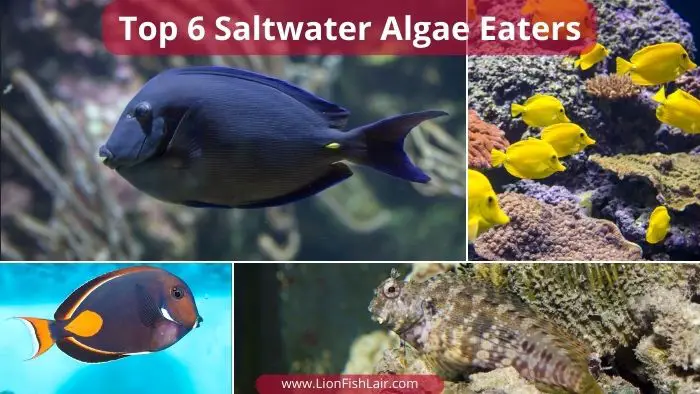
Algae is all too common in both saltwater fish tanks and freshwater fish tanks. Fortunately, there are many good choices for both fish tank types that are good-natured and do a fantastic job of cleaning your aquarium and preventing the spread of algae.
In this list, we discuss the best saltwater algae eaters and all the benefits they will inevitably bring to your tank. Something to bear in mind is that the fish mentioned in this list are peaceful fish too, with the odd aggressive fish anomaly.
6 Best Saltwater Algae Eaters (List)
The fish that feature on this list not only help with cleaning your tank by feeding on algae, but they will also do a good job of removing other harmful bacteria from your tank, helping reduce the chance of diseases for your community due to dirty water and unclean decor. The clean-up crew that features on this list are all fish, there are brilliant non-fish tank cleaners that you should consider too, but for now, we are going to tell you all about the best algae eating fish.
1. Brown Barred Goby
The Brown Barred Goby is an awesome fish with a brilliant personality. They originate from the Indo-Pacific Ocean and sport a brown-green/yellow head with blue and orange dots and dashes, there are brown bands that can be seen across the rest of their body. They tend to eat pretty much all types of algae but they particularly enjoy grazing on filamentous green microalgae.
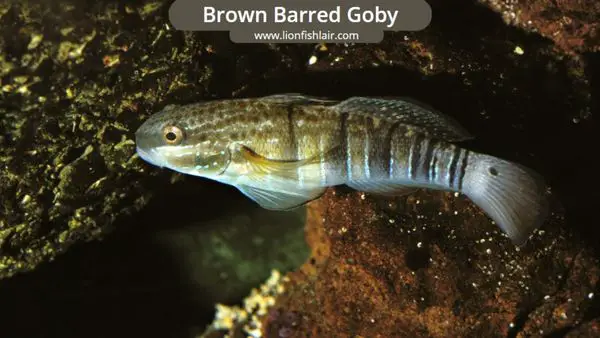
Key Information on the Brown Barred Goby
- Need to be housed in a 30 Gallon (113 Liter) tank or larger.
- They grow to 6 inches (15 cm) in length.
- 78°F (25°C) is the ideal temperature.
- You should feed them in addition to their algae diet with non-living meaty foods. Mysis shrimp, brine shrimp, and chopped seafood are all good options.
2. Achilles Tang
Achilles Tangs are another beautiful member of this popular saltwater family that is perfect for algae control. Originating from the waters of the Western Pacific close to the islands of Oceania in addition to Pitcairn and the Hawaiian Islands. These tangs are truly mesmerizing, sporting a typical tang-like body shape with a dark-navy body color in addition to bright orange spots on their lower body and tail. Most importantly, they will take care of massive algae growth by typically feeding off blue-green, red, and green microalgae.
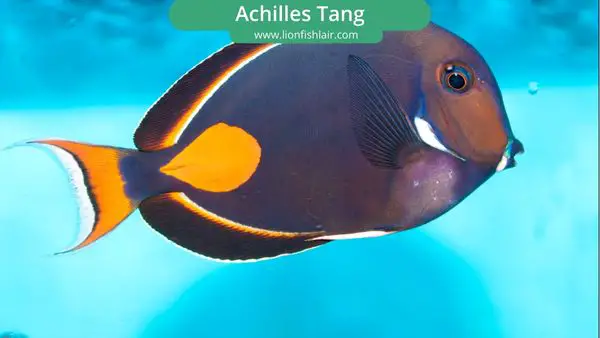
Key Information on the Achilles Tang
- Need to be housed in a 50 Gallon (190 Liter) tank or larger.
- They grow to 10 inches (25 cm) in length.
- 78°F (25°C) is the ideal temperature.
- You should feed them in addition to their algae diet with frozen and meaty foods. Shrimp, chopped seafood, and frozen foods are all good options.
3. Atlantic Blue Tang
The Atlantic Blue Tang is an all-blue tang family member with an awesome appearance and playful personality. These fish originate from the Caribbean Sea, specifically in the shallow reefs of the Dominican Republic. You can also find them in the Bahamas, Florida, Belize, Bonaire, Brazil, and the Gulf of Mexico. They will keep your tank nice and clean by feeding off fleshy brown microalgae, filamentous green red, and blue-green microalgae!
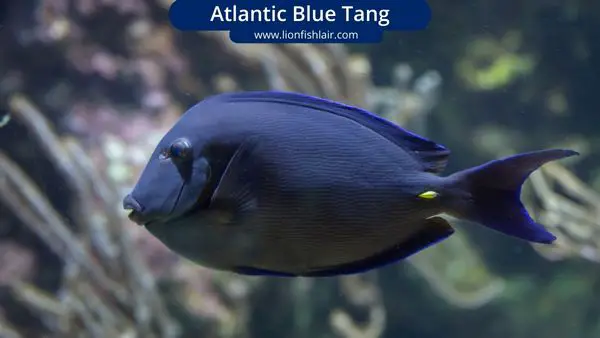
Key Information on the Atlantic Blue Tang
- Need to be housed in a 100-gallon (378 Liter) tank or larger.
- They grow to 9 inches (23 cm) in length.
- 79°F (26°C) is the ideal temperature.
- As well as feeding off algae in your fish tank they will feed off the algae residing on other fish within your tank too, cleaning them whilst providing these tangs with a meal.
4. Cherub Angelfish
Cherub Angelfish are as tropical-looking as it gets, sporting a bright purple body with a neon-yellow head. They originate from the Western Atlantic but have been found in the Gulf of Mexico, and more specifically Florida. These Angelfish will make light work of harmful detritus and filamentous green microalgae in addition to filamentous blue-green microalgae.
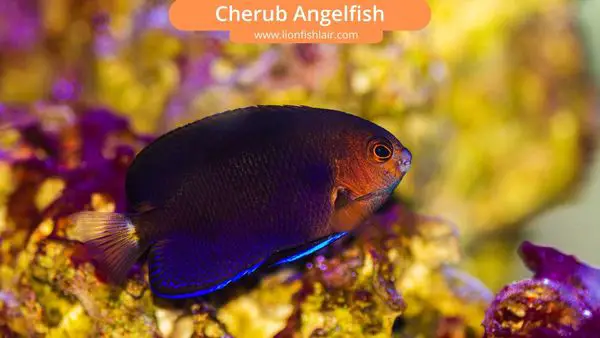
Key Information on the Cherub Angelfish
- Need to be housed in a 30 Gallon (114 Liter) tank or larger.
- They grow to 3.2 inches (8 cm) in length.
- 78°F (25°C) is the ideal temperature.
- They need a balanced diet consisting of both vegetables and meat as well as the obvious one, algae!
5. Lawnmower Blenny
This member of the blenny family would be impossible to not include on this list, right? The name alone says it all, and they certainly live up to the lawnmower name, literally mowing down all the algae and bacteria they discover with ease. Originating from the Indian Ocean, off the East African Coast, these blennys will eat diatoms, filamentous blue-green, and green microalgae in addition to detritus.
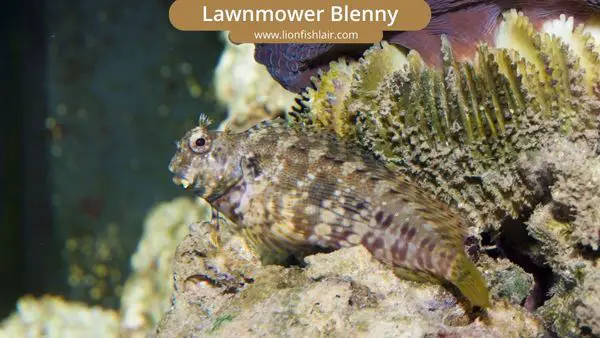
Key Information on the Lawnmower Blenny
- Need to be housed in a 55 Gallon (208 Liter) tank or larger.
- They grow to 5.5 inches (14 cm) in length.
- 78°F (25°C) is the ideal temperature.
- They are herbivores, so if they are not getting enough algae from your tank you should feed them with additional veggies you can purchase at fishkeeping stores or online.
6. Yellow Tang
Originating from the Pacific and Indian oceans, and more specifically the waters of Hawaii is the sensational little fish, the Yellow Tang. Yellow Tangs are tremendously popular among hobbyists, this is due to their bright, almost neon-colored bodies as well as their awesome sail-shaped bodies. They make a fantastic addition to any saltwater aquarium, especially one with a cleanliness problem! They will feed off filamentous blue-green, brown, green, and red microalgae, as well as hair algae.
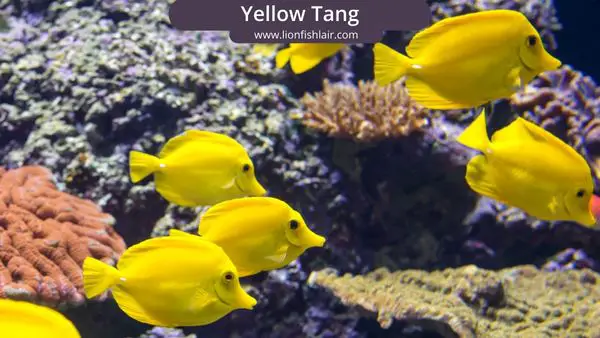
Key Information on the Yellow Tang
- Need to be housed in a 100-gallon (368 Liter) tank or larger.
- They grow to 5.5 inches (14 cm) in length.
- 82°F (28°C) is the ideal temperature.
- They will primarily feed off algae, however, they can be fed a balanced diet of both meats and vegetables in addition to this.
Different Types Of Saltwater Algae
The real issue with saltwater algae and more importantly removing it from your tank via the usage of certain fish is that not all algae are the same. As you will have seen from this guide there are many different species of algae that are only eaten by certain fish. Whilst a fish may enjoy one type of algae, it may hate another and not go near it. There are two main types:

Filamentous Microalgae
This species of algae are perhaps the most common, and the most basic in terms of its structure and tendencies. The most commonly found algae from this species are the nightmarish Green Alga, Hair Algae, or Algal Films.
Fleshy Macroalgae
These algae are more complex and plant-like than the other types of algae. These algae include Caulerpa, Ulva, and Halimeda algae.
Other Types of Algae
Despite there being two main types of reef aquarium algae, there are a few other types that you might see growing in your saltwater aquarium:
- Red slime algae
- Brown algae
- Nuisance algae
- Filamentous algae
- Bubble algae
- Coralline algae
Conclusion
The fish that are listed in this article will help you out considerably if you have an algae infestation on your hands, however, they are not all guaranteed to feed off every possible type of algae out there, which is why it is a sensible idea to use other measures for removing algae in addition to introducing these algae-eating fish to your tank.
Additionally, some of the fish mentioned here might not get along with the fish you already own. This is an all too common mistake made by hobbyists, which is why careful consideration and research must be conducted to make sure your fish are compatible with your desired algae eater.

